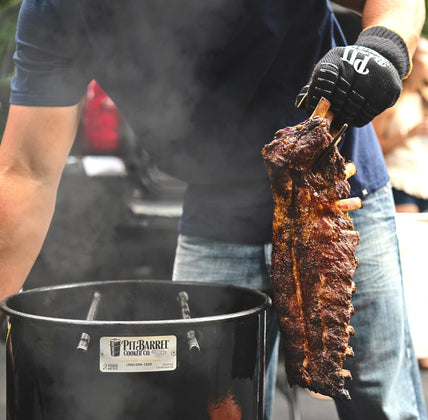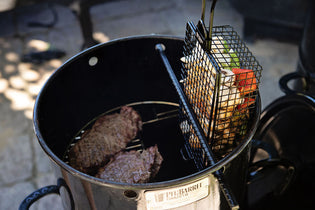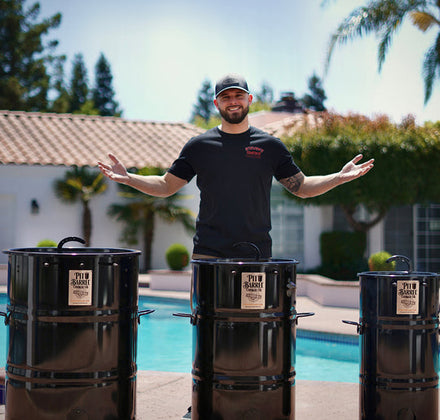PULLED PORK |
||||
CATEGORYMeat |
SERVINGS6 |
PREP TIME20 minutes |
COOK TIME300 minutes |
CALORIES425 |
|
When it comes to smoked meats, there is nothing like a slow cooked pork shoulder. When done well, the meat practically melts in your mouth and the flavor is unbelievable. Incredibly versatile, pulled pork can stand on its own, make a sandwich, or top a taco. You can find a vast assortment of pulled pork recipes across the internet. Almost any dish that has a meat component can be made using pulled pork instead of the usual chicken or beef. It is a relatively cheap cut of meat, can feed a lot of people, and is simple to cook, which makes it a favorite for families and large gatherings. Cooking your pulled pork in most smokers, or even in a slow cooker, can often take upwards of twelve hours, but with the Pit Barrel® it will be ready to eat in less than six! Many who are new to barbeque may wonder what cut of meat to use for pulled pork. Recipes may call for pork shoulders, pork butts, or Boston butts, and all this terminology can get confusing. The good news is these are all different names for the same thing. Pulled pork is usually made from the “butt” end of the pig’s shoulder, the top of the front leg. “Butt” sounds like it should come from the rear legs, but that is where a ham comes from. So next time you go to the grocery and come across a cut of pork labelled “pork shoulder butt,” you know it is all the same piece of meat. The Pit Barrel® provides a unique flavor that you won’t get with any other cooking method. Hanging your meat directly above the charcoal basket allows the drippings to fall onto the coals and vaporize. These vapors mix with your smoke and infuse back into your meat as it cooks. This flavor is often so good people won’t even bother with bbq sauce or rubs, but there are endless ways to change it up when you want to. It can be as simple as adding a handful of woodchips of your choice to adjust the smoke flavor. You can always coat your pork shoulder in your favorite dry rub, and we highly recommend checking out our signature Pit Rubs. Throw a little brown sugar in the rub if you like a sweeter meat. If you want even more flavor infused in your meat during the cook, try a different liquid when you wrap it. Beer, apple juice, and broth are common, but you can mix it up with some ginger ale, pineapple juice, apple cider vinegar, or get even more creative! If you are cooking for a pickier crowd, sauces may be a better option to add flavor. If you trust the smoke to flavor your meat, then each person can add whatever sauce in whatever amount they want to suit their taste. Pulled pork is an American household favorite. Great for sandwiches or comfort dishes, this recipe is perfect for the Pit Barrel®. Author:
|
||||
INGREDIENTSSPARERIBS
|
DIRECTIONS
|
|||
RECIPE VIDEO |
||||
RECIPE NOTEDesired Temp: 195º The final internal temperature of your pork shoulder is a topic of serious debate among barbeque enthusiasts. The opinions can range from 180°-205°F, though the most common suggestions will be around 195°-203°F. Pork is technically safe to eat at 145°F but bringing it to a higher temperature breaks down the connective tissue, leaving you with tender meat that should basically fall apart when you pull or shred it. Best practice is to use internal temp as a general guide, but to check the tenderness of the meat to confirm that it is done. When you stick a thermometer probe or small skewer into the meat, it should slide right in like you are cutting warm butter. You can also use the bone as a reference point, as you should be able to pull it out easily when your meat is done. You can start testing this when the internal temperature gets up to 195F, but leave it in the cooker until it reaches your desired tenderness according the probe test. To Rest or Not to Rest?This seems to be the question most debated among pork smoking afficionados. Some say you should only let it sit long enough that it gets cool enough to pull, while others will suggest letting it rest anywhere from 30 minutes to several hours. The thought behind resting your meat is that if you wrap it and leave it to rest in an empty cooler, it will continue to cook from the carryover heat. This will cause the internal temperature to continue to rise a few more degrees and the connective tissues will break down further. If you wrap your pork shoulder to get it through the stall, lots of liquid will remain in the foil as it cooks out of the meat. Many pro-resters will say that letting your meat rest before you unwrap it will allow some of this liquid to reabsorb into the meat and will make your final product more moist. Those who do not recommend resting counter that if you know your meat has already reached peak tenderness using the probe test, then it won’t do any good to try to make it more tender by resting. They will also say that when you shred the meat you will mix all the juices back in, so there is no point to letting them soak into the meat after your cook. Do we have the answer? No. It will ultimately be up to your preference and your experience. What we can say is that well-cooked pulled pork off the Pit Barrel® is phenomenal, no matter how you choose to finish it. You can never go wrong with a classic pulled pork sandwich. If you ever feel like elevating your meal or repurposing your leftovers, check out this Pulled Pork Vietnamese Salad, Keto Pulled Pork Chaffle, or try it with this incredible Honey Crisp Slaw. If you have a favorite recipe and some leftover pork, substitute the pork for the usual meat in your recipe and take it to the next level. This works great with egg rolls, enchiladas, pizza, or even mac n’ cheese. |
||||



